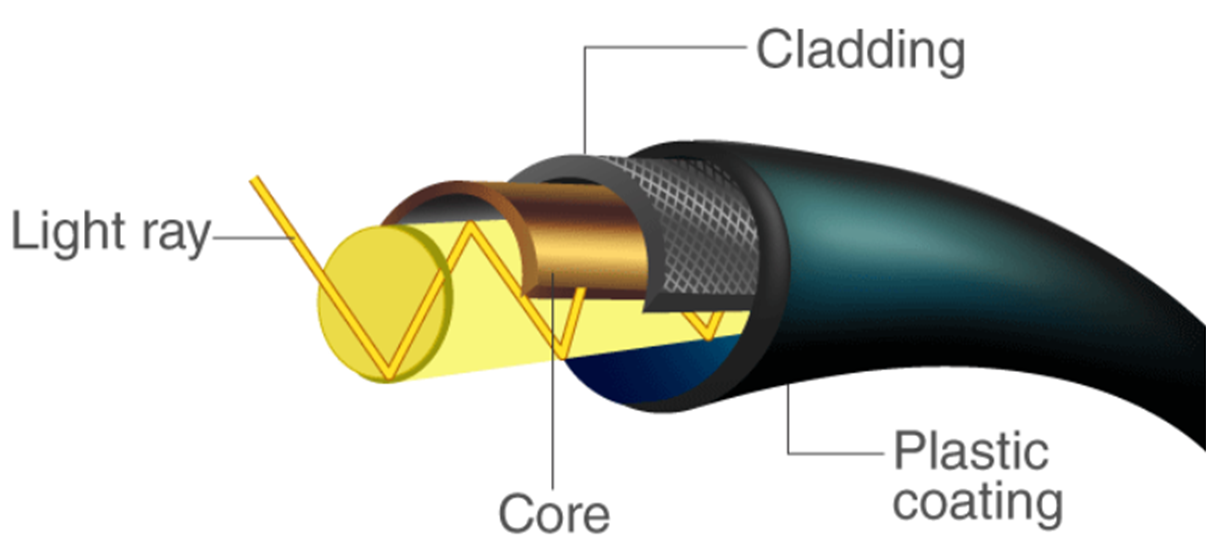Fibre Optic Cables | 29 Nov 2023
For Prelims: Fibre Optic Cables, Optical Fibres, Charles Kao, Total Internal Reflection, National Mission on Quantum Technologies and Applications.
For Mains: Fibre Optic Cables, Evolution of Internet, Challenges in Fibreisation, Government’s Initiative.
Why in News?
With the increasing demand for high-speed internet connections Optical Fibres have been materialized into the present-day reality of high-speed data transmission.
What is an Optical Fibre?
- About:
- Optical Fibres are thin, cylindrical strands composed of glass, with a diameter typically comparable to that of a human hair.
- These fibres possess the remarkable ability to transmit various forms of information, including text, images, audio, video, phone calls, and any data that can be digitized, across vast distances at speeds approaching that of light.
- They are strong, lightweight, and remarkably flexible, making them suitable for burial underground, submersion underwater, or coiling around a spool.
- Almost 60 years ago, physicist Charles Kao proposed the concept of using glass Fibres as a superior medium for telecommunications, superseding the prevalent copper wires.
- His groundbreaking contributions to Fibre optic communication earned him a share of the 2009 Nobel Prize in Physics.
- Working:
- Principle of Total Internal Reflection: The phenomenon of Total Internal Reflection (TIR) forms the basis for guiding light within optical Fibres.
- If light travels from a higher refractive index medium (like glass) to a lower one (such as air) at a specific angle, it may not exit the medium but be entirely reflected back within it. This phenomenon is called TIR.
- Signal Encoding: Information is encoded into optical signals as rapidly blinking light pulses, typically representing binary digits (zeros and ones).
- These optical signals are fed into one end of an optical Fibre, where they travel by reflecting and bouncing between the glass walls due to total internal reflection.
- Signal Transport: The optical Fibre carries the encoded signals across several kilometers without significant loss of signal integrity.
- At the destination, a receiver reproduces the encoded information from the transmitted optical signal.
- Principle of Total Internal Reflection: The phenomenon of Total Internal Reflection (TIR) forms the basis for guiding light within optical Fibres.
- Benefits:
- High Speed: Fibre provides more bandwidth and has standardized performance up to 10 Gbps and beyond, something that it is impossible to achieve when using copper.
- More bandwidth means that Fibre can carry more information with far greater efficiency than copper wire.
- Range of Transmission: Since data travels in the form of light in Fibre-optic cables, very little signal loss occurs during transmission and data can move at higher speeds and greater distances.
- Not susceptible to interference: Fibre-optic cable is also much less susceptible to noise and electromagnetic interference than copper wire.
- It is so efficient, in fact, that roughly 99.7% of the signal reaches the router in most cases.
- Durability: Fibre-optic cable is completely immune to many environmental factors that affect copper cable.
- The core is made of glass, which is an insulator, so no electric current can flow through.
- High Speed: Fibre provides more bandwidth and has standardized performance up to 10 Gbps and beyond, something that it is impossible to achieve when using copper.
What is the Current Scenario of Fibre Optics in India?
- Fibre optics technology has since been widely used in telecommunication, medical science, laser technology, and sensing.
- With a goal to securing communication and promoting quantum science, the Government of India announced a national mission in the Union Budget of 2020. The proposed budget for this ‘National Mission on Quantum Technologies and Applications’ is Rs 8,000 crore over a period of five years.
- The possibilities of fibre optic networks are growing at an accelerated rate, reaching all the way into our homes. Along with quantum optics, fibre optic communication stands on the cusp of a new era.

